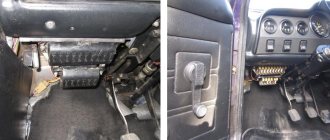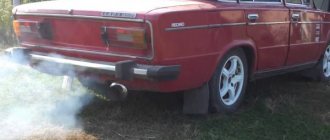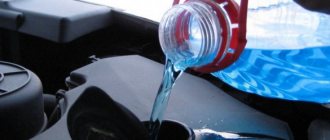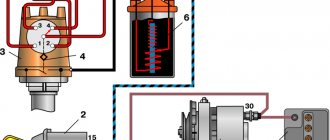Hello, dear friends! Many of those who operate a car have probably encountered a situation where water drips from the exhaust pipe.
At the same time, some immediately begin to panic, believing that such phenomena have serious causes. When starting the engine, the exhaust often steams during warm-up. Moreover, this should not be confused with smoke.
Most often, fumes and water from the exhaust system are clearly visible in winter or autumn, during wet and cold weather. Although it also occurs in summer. But is the formation of vapor clouds and liquid droplets escaping through the exhaust pipe of a vehicle really dangerous?! In reality, everything is not so scary.
The basis of this phenomenon is condensation. It is because of this that water sometimes literally pours, leaving behind a stain on the asphalt. Let's look at the reasons and what needs to be done in such situations.
Possible reasons
First, you need to find out exactly why water can appear and what exactly happens to the car.
Moreover, it doesn’t matter whether you bought a brand new Renault Captur or are using an old VAZ 2114. A characteristic sign in the form of dripping water, which often complements white smoke, is found on any car. That’s why owners of vehicles of various categories turn to forums with similar questions, ranging from old, sometimes even Soviet cars, to developments from leading auto companies, released almost a few months ago.
In most cases, motorists are faced with a simple physical phenomenon called condensation. Its formation is determined by the simplest laws of physics.
But there are cases when water and a large amount of steam indicate serious malfunctions, such as a broken head gasket or even a crack in the cylinder head.
Before thinking about how to remove water from the muffler, let's look at the reasons for its appearance.
All internal combustion engines heat up to very high temperatures during operation. Heat removal is ensured by the presence of a cooling system. In this case, the exhaust tract still remains heated. The intake pipes and exhaust manifold can warm up to 500-700 degrees Celsius, which is due to their location near the engine. And the pipes located a little further, like the muffler with the resonator, do not overheat as much. Although temperatures are still high.
When the engine stops, the steam that appears in the exhaust pipe begins to gradually settle on the inner walls. Steam, as you know, is one of the aggregate states of water.
It is these vapors that gradually turn into ordinary water. This is why, during a cold start, water often comes out of the exhaust, but when the engine is warm, everything goes away, since the high temperature promotes the complete evaporation of accumulated moisture.
Why does a lot of water collect in the muffler?
Noticing condensation dripping from the exhaust pipe, an inexperienced car owner either panics or is perplexed. Rushing to the nearest service station is not the smartest idea. Several factors contribute to the accumulation of moisture in the inside of the pipe. You need to understand them in more detail:
- driving in winter - the difference in temperature outside the muffler and inside it makes itself felt;
- infrequent use of the car - short short trips are fraught with increased condensation;
- modern exhaust gas purification – their design entails side effects.
When driving in winter
The cold season is the best condition for the formation of condensation in the muffler. The air temperature outside the exhaust pipe is much lower than inside it. So the moisture does not evaporate, but settles in a liquid state. Automatic warming up of the car partially solves the problem with condensation. But moisture still remains on the cold components of the exhaust system, because the idle speed is not so high as to blow it out with a stream of gases. Therefore, water settles inside the muffler, accumulating with each new heating.
When using the car infrequently
The shorter the trips, the worse the muffler warms up, which means less intense evaporation of moisture. It will settle inside the exhaust pipe in larger volumes than during long-term operation. Car owners who make long trips experience less difficulty with condensation in the muffler. The same cannot be said about those who use their iron horse only for short “home-work-home” forays.
In cars with modern exhaust gas cleaning systems
Due to the catalyst (emission system), condensation can flow while driving the car. A lot of substances come out of the cylinders and are sent to the exhaust manifold. The process is accompanied by the release of nitrogen oxides, carbon monoxide, unburned hydrocarbons, carbon dioxide, oxygen and water. Only the last three elements are harmless to humans. All the rest go to the car's catalyst, where they are oxidized by platinum and palladium. This is how carbon dioxide and water vapor are formed. The latter remains inside the muffler.
Tire sealant: what is it for, what are they?
This phenomenon is considered normal for the early spring and autumn-winter periods. Moreover, the most active accumulation of water in the exhaust system occurs precisely when the car is operated for short trips. The old moisture does not have time to evaporate, and at the same time new condensation appears. If you observe something similar that happens after the machine is brought to operating temperature, you should not worry at all. These are natural physical processes.
It’s another matter when, after heating, steam still appears in large volumes. There is no need to talk about black or blue smoke at all. This is a slightly different category.
The motorist should pay attention not only to the color of the liquid, but also to the nature of the smoke. I'll tell you more about this a little later.
And so, the engine has warmed up, but clouds of steam still come out of the pipe. Here you should pay attention to the following signs of a possible malfunction:
What to do if condensation appears in the car exhaust pipe
Climatic conditions and the operating principle of the internal combustion engine cause the formation of condensed steam in the exhaust gas exhaust system. To evaporate it, it is enough to take a long trip lasting more than an hour once a week.
You need to go to a service station for diagnostics if the exhaust gases have bluish or black smoke, a large amount of soot settles on the walls of the pipe, or there are malfunctions in the functioning of the cooling system or engine.
Is it possible to drill a muffler?
The procedure is ambiguous. On the one hand, liquid is removed from the exhaust system through the holes, on the other hand, two problems arise:
- the exhaust sound becomes louder;
- an element made of ordinary steel fails prematurely.
Under the influence of high temperatures, reagents, and moisture, a small hole will steadily increase. The same thing will happen with a stainless steel part, but at a slower pace.
Note: How and how to paint car rims yourself
Instead of drilling into the muffler, experts recommend that car owners create conditions that will prevent the formation of condensed steam in significant quantities.
Replacing a catalyst with a flame arrester: what consequences can there be
- Coolant is boiling in the expansion tank. Not the best sign, the reasons for which vary;
- In the same expansion tank, the fluid level drops. Moreover, after adding coolant, it disappears again in a short period of time;
- If you over-gas, a thick cloud of steam comes out of the exhaust, which is accompanied by drops of moisture;
- The temperature sensor is triggered and reports overheating of the power plant.
An unpleasant situation that often requires disassembling the cylinder block and removing its head. It's hard not to notice a broken gasket.
In addition to violating the integrity of the cylinder head gasket, deformation of the contact surface between the block and its head cannot be ruled out.
How does moisture get inside the muffler?
We regularly encounter the phenomenon of condensation in everyday life, and it is always undesirable, no matter where it occurs, and sometimes it can act destructively on structures, being also one of the provoking factors for corrosion. Every schoolchild knows from physics lessons where condensation comes from, and if water begins to flow out of the muffler, which can most often be detected when starting a cold engine, then this is not a sign of design defects. Let's take a closer look at why water drips from the muffler, which promotes condensation. The reasons for the formation of condensation in the exhaust system of a car lie in physical processes, as well as chemical reactions occurring in the internal combustion engine chamber:
- Droplets settle on surfaces or inside structures, falling out of the air, since the content of water vapor in it depends on temperature. Condensation as a result of contact of hot elements with cold air outside the car is a normal phenomenon. When the temperature drops to the dew point, excess moisture always settles in drops on objects, so the heating of the motor and the contact of heated elements with cold air is the main cause of condensation. The lower the temperature, the less the air retains moisture in a gaseous state, which explains the fact that in winter condensation appears more actively, which is why water comes out of the exhaust pipe. In the cold season, the transition of water from one state to another is observed much more often, and icicles hanging from the end of the muffler are also the result of normal natural processes. In summer the problem is less noticeable, but still occurs. Condensation in the muffler collects more intensely when the air is saturated with water vapor, as in times of rain and fog, as well as during significant temperature differences;
- Water is also released as a result of the chemical reaction of fuel combustion (gasoline, diesel fuel or liquefied gas). During the combustion of the mixture, the reaction of carbon and hydrogen with oxygen forms carbon dioxide and water vapor, which is emitted through the exhaust system, partially settling there in the form of condensate;
- Water vapor is also formed during the afterburning of gases in the catalytic converter. Unburned carbon monoxide, along with the exhaust, goes straight to the catalyst, where it undergoes oxidation. The steam burns out, resulting in the release of water.
Thus, the reasons why water leaks from the muffler can be external and internal. It is impossible to eliminate the formation of condensation that occurs naturally, although there are ways to reduce the extent of its manifestation by creating special conditions.
Note the smoke and color of the liquid
We have already found out that with a cold engine while the engine is warming up, there is nothing wrong with the appearance of water and white smoke. This is just steam, which will soon evaporate completely and stop dripping from the pipe.
But it happens that the character of the smoke is completely different, dark or bluish in color. At the same time, not just water flows out, but some kind of black liquid. Sometimes motorists note that the color of the water is yellow.
It is worth considering all these situations and possible reasons for their occurrence.
How does moisture get inside the muffler?
In the vast majority of cases, splashes of water escaping from the exhaust pipe do not indicate any failure and do not pose a danger to the “health” of the car. Splashes can be observed on almost all cars, regardless of class and model. The reasons for the formation of moisture lie in ordinary physical phenomena and chemical reactions occurring inside the engine and exhaust tract:
- Condensation resulting from contact of hot surfaces with cold outside air.
- The release of water as a product of the chemical reaction of hydrocarbon fuel combustion occurring in the cylinders of the power unit.
- During residual afterburning of combustible gases, water vapor also forms inside the catalytic converter.
Each reason requires detailed explanation. In the first case, moisture forms after stopping the running engine, when the exhaust tract has become thoroughly heated. Water vapor suspended in the air condenses upon contact with hot surfaces. The more humid the outside air and the greater the temperature difference, the more intense condensation occurs. This is why much more liquid flows out of the pipe in winter than in summer.
Reference. The greatest amount of condensation occurs during periods of rain and fog, when the air is oversaturated with moisture.
Water vapor is also a product of combustion of gasoline, liquefied gas and diesel fuel. When oxidized, a hydrocarbon compound disintegrates with the release of heat. As a result of a chemical reaction, 2 substances are formed - carbon dioxide and water, which evaporate at the time of combustion. The steam is released through the valves into the exhaust pipe, where it partially condenses.
Since the combustion conditions of gasoline are not very ideal, unburnt carbon monoxide (CO) is formed in the chambers, which is sent along with the exhaust to the catalyst. There the final oxidation and combustion of gasoline vapors occurs, again releasing water.
Force tool set: review, reviews, which one to buy
- Blue smoke and dark liquid color. If the clouds of smoke are thick and characterized by this color, then the elements of the cylinder-piston group have probably worn out and the piston rings have become stuck. You urgently need to contact an experienced mechanic;
- The smoke is black and the liquid is of a similar color. Here you will have to check the condition of the fuel system. Excessive consumption of fuel occurs, fuel is mixed with oil due to a violation of the integrity of connections, gaskets, etc.;
- Gray but weak smoke is most often associated with hardened valve stem seals. They will have to be changed. If you have a turbo engine, then it is possible that the turbocharger itself may break down.;
- Yellow color of water. The situation here is ambiguous. Many motorists claim that the yellow color is due to the coloring of fuel at some gas stations. This is quite consistent with reality, so this option should not be ruled out. Or the exhaust system has rusted from the inside, that is, yellow water is a banal consequence of rust formation.
There is nothing good about black smoke. In the vast majority of cases, fuel burns poorly or incorrectly. The reasons themselves may lie in pinched valves, clogged injectors, a broken carburetor, a clogged air filter, a broken high-pressure pump, etc.
Freezing of the muffler due to the accumulation of condensate in it
If the car is left in an open parking lot in the cold in winter, a lot of moisture can accumulate in the exhaust system, and water often freezes in a low elbow and in a narrow place. As a result, ice blocks the passage of exhaust gases, problems arise with starting the internal combustion engine - the car will start, then immediately stall. In such cases, it is necessary to warm up or tap (clean) the exhaust tract, but in general there are several solutions:
- try to clean the pipe if ice has formed at the back (not in the elbow between the cans);
- tow the car to a warm garage or service station;
- warm up the “outlet” using a hair dryer;
- use the services of visiting specialists;
- take the car to a car wash to warm up the muffler using hot water.
Heating with an open flame (gas burner, blowtorch, etc.) is not recommended; all other methods can be considered.
And in order to avoid the repetition of such cases, holes must still be made in the muffler, you should also gas the car to blow out condensation before parking, do this also when starting the car, park the car not on a descent, but on an ascent. Video - Water drips from the muffler:
Related articles:
- Replacing the camshaft on VAZ, Renault, Chevrolet and Opel cars Replacing the camshaft is required as the part wears out - both the supports and the cams can wear out. The camshaft (CV) may also have other defects - on different car models [...]
- Body types of cars and trucks Modern cars can differ in their appearance and dimensions. There are all sorts of car body types, and the bodies are different for both cars and trucks [...]
- The best-selling cars in Russia In recent years, the Russian automobile market has dropped by about 30% from 2.1 million cars sold in 2014 to 1.63 million cars sold in 2015. Today the most [...]
How to check the catalyst for clogging without removing it from the car with your own hands
If you are concerned about the presence of water droplets and white smoke (steam), but there are no other signs of engine problems, there is no need to worry. If desired, you can follow a few simple rules so that condensation occurs in a smaller volume.
To reduce steam output you can:
- periodically travel not only short distances, but also carry out long trips;
- make a hole in the resonator through which condensate will escape;
- Give it a good throttle when the engine is warm, then turn it off.
By the way, on some cars a drain hole is provided from the factory. There is no need to drill anything additional here.
And I’ll say a few more words regarding the freezing of water in the exhaust system. If ice forms in narrow passages, then the exhaust removal process will be disrupted, the engine will no longer start normally or will stall.
Is it possible to reduce the amount of liquid in the exhaust?
The intensity of condensation inside the exhaust system is practically independent of the make and model of the car. It should be understood that a small amount of water in the pipe is normal. The exception is a situation when liquid flows like a river due to a cylinder head gasket failure.
Since you can't control the chemical reaction of gasoline burning to release water vapor, try to combat condensation. What is needed for this:
- reduce the temperature difference between the heated surface of the pipe and the surrounding air;
- reduce the humidity of air in contact with hot flues;
- create conditions for natural evaporation of condensate.
There is only one way to meet these requirements - store the car in a warm, tightly closed garage equipped with exhaust ventilation. Less moisture will fall out of the heated and drier air, and thanks to the positive temperature, the condensate will evaporate during parking and be removed through the hood. Please note that it will not be possible to completely get rid of water droplets from the muffler.
How does moisture get inside the muffler?
We regularly encounter the phenomenon of condensation in everyday life, and it is always undesirable, no matter where it occurs, and sometimes it can act destructively on structures, being also one of the provoking factors for corrosion. Every schoolchild knows from physics lessons where condensation comes from, and if water begins to flow out of the muffler, which can most often be detected when starting a cold engine, then this is not a sign of design defects. Let's take a closer look at why water drips from the muffler, which promotes condensation. The reasons for the formation of condensation in the exhaust system of a car lie in physical processes, as well as chemical reactions occurring in the internal combustion engine chamber:
- Droplets settle on surfaces or inside structures, falling out of the air, since the content of water vapor in it depends on temperature. Condensation as a result of contact of hot elements with cold air outside the car is a normal phenomenon. When the temperature drops to the dew point, excess moisture always settles in drops on objects, so the heating of the motor and the contact of heated elements with cold air is the main cause of condensation. The lower the temperature, the less the air retains moisture in a gaseous state, which explains the fact that in winter condensation appears more actively, which is why water comes out of the exhaust pipe. In the cold season, the transition of water from one state to another is observed much more often, and icicles hanging from the end of the muffler are also the result of normal natural processes. In summer the problem is less noticeable, but still occurs. Condensation in the muffler collects more intensely when the air is saturated with water vapor, as in times of rain and fog, as well as during significant temperature differences;
- Water is also released as a result of the chemical reaction of fuel combustion (gasoline, diesel fuel or liquefied gas). During the combustion of the mixture, the reaction of carbon and hydrogen with oxygen forms carbon dioxide and water vapor, which is emitted through the exhaust system, partially settling there in the form of condensate;
- Water vapor is also formed during the afterburning of gases in the catalytic converter. Unburned carbon monoxide, along with the exhaust, goes straight to the catalyst, where it undergoes oxidation. The steam burns out, resulting in the release of water.
Thus, the reasons why water leaks from the muffler can be external and internal. It is impossible to eliminate the formation of condensation that occurs naturally, although there are ways to reduce the extent of its manifestation by creating special conditions.











